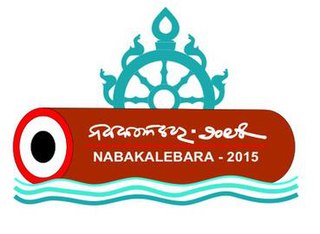| Ratha Yatra of Nabha | |
|---|---|
 Nabha Rathayatra, 2015 | |
| Founded | 25 September 2014 |
| Founded By | Committee Mandir Thakur Shri Saty Narayan Ji |
| Abolished By | ISKCON |
| Place | Nabha, Punjab, India |
| Organizer | Committee Mandir Thakur Shri Saty Narayan Ji |
Ratha Yatra (Oriya: ରଥଯାତ୍ରା or Ratha Jatra or Chariot Festival) is a Hindu festival associated with the god Jagannath held at Mandir Thakur Shri Saty Narayan Ji in the Nabha City, state of Punjab, India. This annual festival is celebrated in the month of August or September. The festival commemorates Jagannath's annual visit to Nabha city.

Jagannath literally means "Lord of the Universe" and is a deity worshipped in regional traditions of Hinduism and Buddhism in India and Bangladesh. Jagannath is considered a form of Vishnu. He is a part of a triad along with his brother Balabhadra and sister Subhadra. To most Vaishnava Hindus, Jagannath is an abstract representation of Krishna; to some Shaiva and Shakta Hindus, he is a symmetry-filled tantric representation of Bhairava; to some Buddhists, he is symbolism for Buddha in the Buddha-Sangha-Dhamma triad; to some Jains, his name and his festive rituals are derived from Jeenanath of Jainism tradition.

Nabha is a historic city and municipal council in the Patiala district to the south-west of the Indian state of Punjab. It was the capital of the former Nabha State.

Punjab is a state in northern India. Forming part of the larger Punjab region of the Indian subcontinent, the state is bordered by the Indian states of Jammu and Kashmir to the north, Himachal Pradesh to the east, Haryana to the south and southeast, Rajasthan to the southwest, and the Pakistani province of Punjab to the west. The state covers an area of 50,362 square kilometres, 1.53% of India's total geographical area. It is the 20th-largest Indian state by area. With 27,704,236 inhabitants at the 2011 census, Punjab is the 16th-largest state by population, comprising 22 districts. Punjabi is the most widely spoken and official language of the state. The main ethnic group are the Punjabis, with Sikhs (58%) forming the demographic majority. The state capital is Chandigarh, a Union Territory and also the capital of the neighbouring state of Haryana. The five tributary rivers of the Indus River from which the region took its name are Sutlej, Ravi, Beas, Chenab and Jhelum Rivers; Sutlej, Ravi and Beas are part of the Indian Punjab.
Contents
As part of Ratha Yatra, the deities of Jagannath, Balabhadra and Subhadra are taken out in a procession to Devi Chowk. Then the deities or Ratha Yatra starts and the Parikrama of the Nabha city. The return journey of Puri Jagannath Ratha Jatra is known as Bahuda Jatra.

In Jainism, Balabhadra or Baladeva are among the sixty-three illustrious beings called śalākāpuruṣas that are said to grace every half cycle of time. According to Jain cosmology, śalākāpuruṣa are born on this earth in every Dukhama-sukhamāara. They comprise twenty-four tīrthaṅkaras, twelve chakravartins, nine balabhadra, nine narayana, and nine pratinarayana. Their life stories are said to be most inspiring. According to the Jain puranas, the Balabhadras lead an ideal Jain life.

Subhadra is a character in the Mahabharata written by Vyasa. She is worshiped as an incarnation of Goddess Yogmaya. In the epic, she is the sister of Krishna and Balarama, wife of Arjuna and mother of Abhimanyu and grandmother of Parikshit. She is the daughter of Vasudeva and Rohini Devi. Subhadra is known as Veera sodari, Veera Patni and Veera matha due to her relationship with Krishna, Arjuna and Abhimanyu respectively.

Three richly decorated chariots, resembling temple structures, are pulled through the streets of Puri called Badadanda. This commemorates the annual journey of Lord Jagannath, Lord Balabhadra, and their sister Subhadra to their aunt's temple, the Gundicha Temple which is situated at a distance of 2 km from their temple. This is the only day when devotees who are not allowed in the temple premises, such as non-Hindus and foreigners, can get their glimpse of the deities. During the festival, devotees from all over the world go to Puri with an earnest desire to help pull the Lords' chariots with the help of other priests pulling the chariots with ropes. They consider this a pious deed and risk their lives in the huge crowd. The huge processions accompanying the chariots play devotional songs with drums, tambourines, trumpets etc. Children line the streets through which the chariot will pass and add to the mass chorus. The Ratha carts themselves are some approximately 45 feet (14 m) high and are pulled by the thousands of pilgrims who turn up for the event; the chariots are built anew each year only from a particular type of tree. Millions of devotees congregate at Puri for this annual event from all over the country and abroad. It is also broadcast live on many Indian, foreign television channels as well as many of the websites telecast jagannath ratha yatra live. [1]

Ratha is the Indo-Iranian term for a spoked-wheel chariot or a cart of antiquity. Its equivalent term in the Dravidian languages is taer.

Gundicha Temple, is a Hindu temple, situated in the temple town of Puri in the state of Odisha, India. It is significant for being the destination of the celebrated annual Rath Yatra of Puri. While it remains vacant most of the year, the temple is occupied by images of the deities of Jagannath, his brother Balabhadra and sister Subhadra for seven complete days every year during the annual Rath Yatra festival.

Temple cars are chariots that are used to carry representations of Hindu gods. The cars are usually used on annual festival days called 'Ther Thiruvizha', during which many people gather around.
























